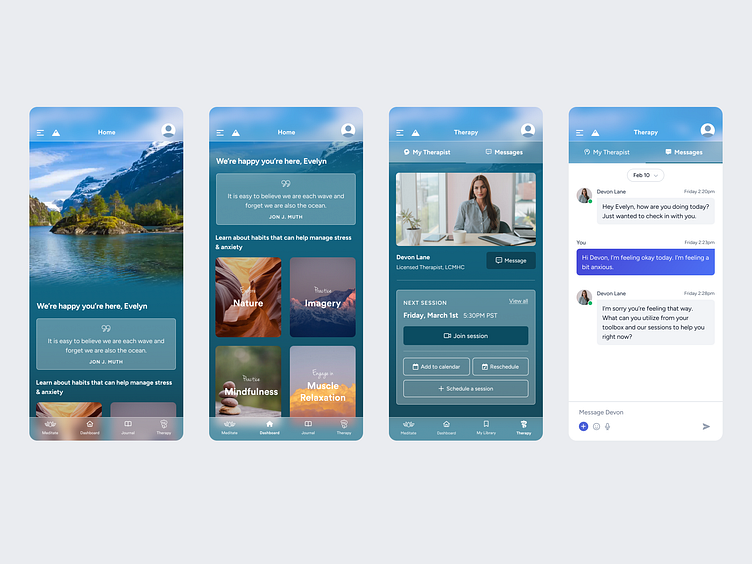BrightHelp - A Different Kind of Mental Health App
Context
BrightHelp is missioned to help people with life challenges with free guided mediation practices, and easily accessible and affordable professional mental therapy counseling services for a healthier and happier mind and soul. The platform provides guided mental health therapy content as well as access to licensed therapists via private and secured messaging and video conferencing.
👩💻 My Role: Lead UI/UX Designer
🔨 Tools: Figma
The Problem
The current mental health applications on the market are bloated, overwhelming, and impersonal.
The Solution
Help users who are struggling with their mental health by:
Providing real, science-backed resources to improve their mental well-being
Creating a safe, calming, relaxing environment that encourages users to step away from the app and look outwards
Providing quality therapy with experienced therapists when users need a bit more help to feel better
Design Process
I followed the "Double Diamond" process to ensure that all design decisions were backed by research and feedback.
Research
Desk Research
According to the CDC, 1 in 5 Americans will experience a mental illness in a given year. Less than half of those affected with a mental illness reach out for help or have access to help.
Competitive Analysis
There are plenty of existing mental health applications already on the market today. Most of these apps are focusing on helping a user learn to meditate, create new habits and stick to them, increase productivity, and reduce stress. However, most of these viable treatments are blocked behind steep paywalls. This decreases user retention and engagement and eventually users drop off entirely, finding themselves feeling hopeless or unmotivated without access to effective help.
The difference between BrightHelp and other apps is that the app educates the user about holistic, effective lifestyle methods that can be incorporated daily to improve their overall well-being. If the user still finds they need some support, they can then connect with a therapist at a reasonable, affordable price.
User Interviews & Surveys
I put together an online survey to send out to people to gather some insights about people's daily routines and whether or not they use existing mental health apps. Due to the sensitive nature of the topic, I ensured all answers were anonymous so people felt secure submitting their responses.
Survey Statistics
The quantitative research involved an online survey of 12 questions which was taken by 51 people. The findings are as follows:
Survey Insights
In addition to the quantitative insights, I was also able to gather feedback on what users think would make for a really great mental health application.
Some were as follows:
"Readily available resources in a written format like articles or blogs or something to read and run through. IE- when looking for idea of support or things to reflect on to grow"
"I think it would be awesome if there’s therapists on the apps that also take my insurance. If not, then it would be best to get a therapist from my PCP."
"Messaging a therapist for people who are not comfortable talking to a therapist on a video call or over the phone"
"Having an app suggesting ways to 1.) move 2.) meditate (with helpful ways to start if you don’t know how) and 3.) outlets to think/talk are the top things that I find helpful in a mental health journey."
User Personas
Empathy Map
Pain points to gain points
Information Architecture
With the help of the previous research, I was able to understand the user's mental model and map out the main functionalities/features of the app.
User flow
Below is an example of one of the user flows I mapped out to show a potential journey throughout the app.
Low fidelity wireframes
The low fidelity wireframes were created to provide a starting point into the visualization of the app's flow, components, and screens.
High fidelity wireframes
Prototype
Below are some of the finished prototypes for certain user flows

















